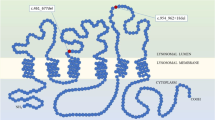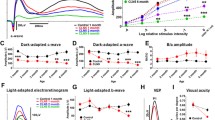Abstract
Purpose
The objective of this study was to establish an ophthalmologic phenotype of heterozygous carriers of juvenile neuronal ceroid lipofuscinosis (CLN3 disease, Batten disease).
Methods
The eyes and vision of nine heterozygous carriers of juvenile neuronal ceroid lipofuscinosis with classical CLN3 mutations were examined using the following methods: clinical examination, visual acuity, ophthalmoscopy, optical coherence tomography (macular thickness and peripapillary retinal nerve fibre layer measurement [RNFL]), fundus autofluorescence measurement, infrared imaging, and full-field and multifocal electroretinogram. Optical coherence tomography and electrophysiological data were statistically compared with age- and sex-matched control groups.
Results
The basic clinical examination as well as the fundus autofluorescence and infrared images of the macular region were unremarkable. Neither the electrophysiological examinations nor optical coherence tomography yielded fundamental abnormalities. There were only two significant—albeit most likely clinically irrelevant—differences that occurred in comparison to the control group: a decrease in RNFL of the nasal quadrant in the OCT and a prolongation of the N1 implicit time of the second-ring eccentricity in the multifocal electroretinogram.
Conclusions
The eyes and vision of heterozygous carriers of CLN3 disease showed normal features when compared to a control group, which controverts a previously suggested retinal dysfunction in these subjects.




Similar content being viewed by others
References
Schulz A, Kohlschütter A, Mink J, Simonati A, Williams R (2013) NCL diseases - clinical perspectives. Biochim Biophys Acta 1832:1801–6
Cotman SL, Staropoli JF (2012) The juvenile Batten disease protein, CLN3, and its role in regulating anterograde and retrograde post-Golgi trafficking. Clin Lipidol 7:79–91
Guldberg P, Henriksen KF, Lou HC, Güttler F (1998) Aberrant phenylalanine metabolism in phenylketonuria heterozygotes. J Inherit Metab Dis 21:365–72
Laberge C, Lescault A, Grenier A, Morrisette J, Gagné R, Gadbois P et al (1990) Oral loading of homogentisic acid in controls and in obligate heterozygotes for hereditary tyrosinemia type I. Am J Hum Genet 47:329–37
Mata NL, Tzekov RT, Liu X, Weng J, Birch DG, Travis GH (2001) Delayed dark-adaptation and lipofuscin accumulation in abcr+/− mice: implications for involvement of ABCR in age-related macular degeneration. Invest Ophthalmol Vis Sci 42:1685–90
Woolf LI (1986) The heterozygote advantage in phenylketonuria. Am J Hum Genet 38:773–5
Gottlob I, Leipert KP, Kohlschütter A, Goebel HH (1988) Electrophysiological findings of neuronal ceroid lipofuscinosis in heterozygotes. Graefes Arch Clin Exp Ophthalmol 226:516–21
Kelly JP, Weiss AH, Rowell G, Seigel GM (2009) Autofluorescence and infrared retinal imaging in patients and obligate carriers with neuronal ceroid lipofuscinosis. Ophthalmic Genet 30:190–8
Marmor MF, Fulton AB, Holder GE, Miyake Y, Brigell M, Bach M (2009) ISCEV Standard for full-field clinical electroretinography (2008 update). Doc Ophthalmol 118:69–77
Hood DC, Bach M, Brigell M, Keating D, Kondo M, Lyons JS et al (2012) ISCEV standard for clinical multifocal electroretinography (mfERG) (2011 edition). Doc Ophthalmol 124:1–13
Acknowledgments
Funding/ Support
This study was funded by donations from the Nächstenliebe (www.ncl-naechstenliebe.de) and Freunde der Kinderklinik UK Eppendorf e.V foundations. Funds were used solely as expense allowance for the participating subjects. All subjects had to travel to Berlin from other parts of Germany. Some subjects stayed overnight in a hotel near the university campus.
Contributions of authors
Design and conduct of the study: RB. AK. AS. WH. KR.
Collection of data: RB. KR.
Management, analysis, and interpretation of data: RB. AK. AS. KR.
Preparation, review, and approval of the manuscript: RB. AK. AS. KR.
Statement regarding conformity of author information
This study was prospectively approved by the ethics committee of the Charité (Ethikkommission der Charité – Universitätsmedizin, Berlin), and all subjects gave informed consent to participate in the trial.
The authors would like to thank Carola Lehrhaft, Anja Brune, and Dirk Scharf for their support with the electrophysiological recordings and retinal imaging.
Conflict of interest
None
Author information
Authors and Affiliations
Corresponding author
Rights and permissions
About this article
Cite this article
Bergholz, R., Kohlschütter, A., Schulz, A. et al. Phenotyping heterozygous carriers of juvenile neuronal ceroid lipofuscinosis with CLN3 mutations. Graefes Arch Clin Exp Ophthalmol 253, 1245–1250 (2015). https://doi.org/10.1007/s00417-014-2814-0
Received:
Revised:
Accepted:
Published:
Issue Date:
DOI: https://doi.org/10.1007/s00417-014-2814-0




